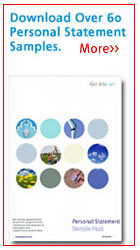Teaching Writing Guide
Getting The Structure Right
Now you have completed the questionnaire, the next process is to review the results and get your structure right. It is important to remember that this is a short personal statement, not an autobiography. Focus on your results from the questionnaire, and be particular about each element that you wish to include. If you are lacking practical experience, demonstrate your interest and ability to study your topic. Below is our recommended structure.
Introduction
Giving your personal statement a strong opening will engage the reader's attention from the outset. Common mistakes include the use of clichéd and overused sentences in the introduction. For example, you should avoid starting your sentence with the following:
“ I always wanted to teach”.
“ I want to teach because”.
“ My passion has always been for teaching”.
Below is an example of a powerful introduction:
"As I left the building, I knew I would never again look at any workplace in the same light; after spending weeks shadowing a headteacher, I had gained insight into the wonderful teaching field that has stayed with me to this day".
The Body
People often forget about the body. It is important to remember that your personal statement must proceed in a logical succession from one thought to the next. The body of the personal statement should lead in a convincing way from the introduction to conclusion. The paragraphing can be used as a planning tool. The beginning of each paragraph should introduce the topic and the paragraph must end in a "hook" to the next paragraph. Whenever possible give the first sentence an interesting angle.
Each paragraph should follow this general structure.
Make sure your sentence is supported by actions.
1. Specific detail (action that supports the point).
2. Specific detail (action that supports the point).
3. Specific detail (action that supports the point).
The Conclusion
Conclude the personal statement with an attention-grabbing sentence. You may find it helpful to reflect on your main accomplishments and experience. The main point of the conclusion is to underline your desire to study. Read the sample conclusion below.
Having reached the conclusion, admissions officers need to feel that they know more about you than when they started.
The fact that you have been swimming every day is impressive, but what is more interesting is the inspiration behind it: the fact that you had met Olympic winner Duncan Goodhew, and why he inspired you.
Remember to keep the discussion personal. How much you revel about yourself is up to you. Many students fall into the trap of keeping the reader at arms length.
Next: Draft Structure Outline.
Note: This guide is not intended to replace the advice of tutors, admissions officers, or teachers; Get Into Uni simply provides advice and exercises to help you write a compelling personal statement.





